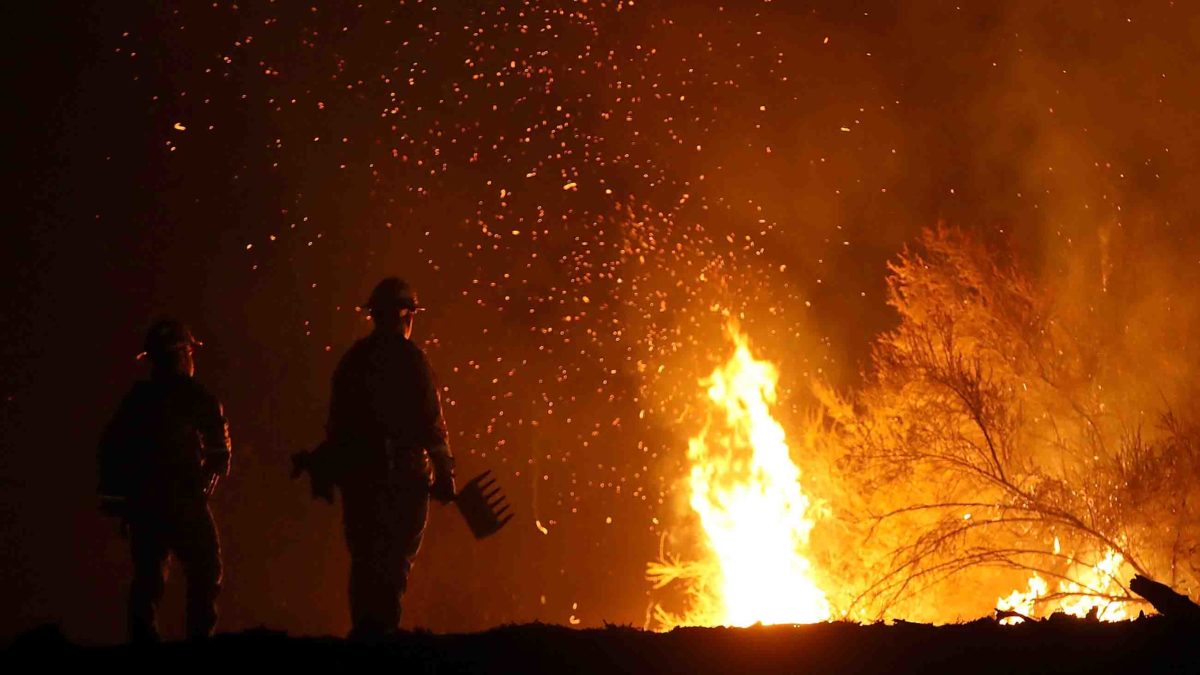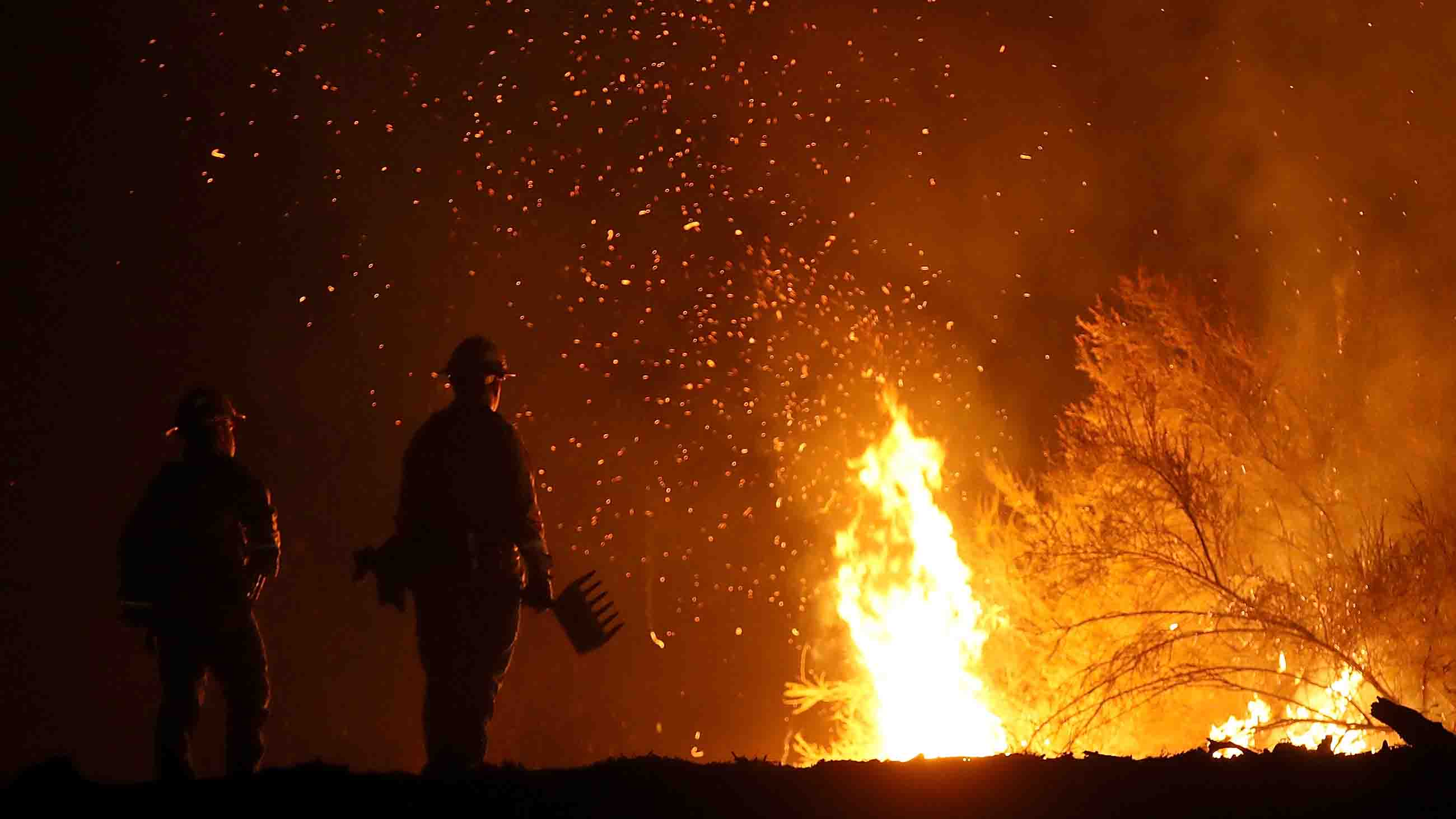As California continues to battle raging wildfires, including its largest ever, people across the West Coast are feeling its effects in the form of dangerous levels of air pollution.

The Mendocino Complex Fire has been deemed the largest wildfire in California state history.
Visual: Justin Sullivan/Getty Images
Earlier this week, Sacramento residents were told to limit their outdoor activities to minimize exposure while the air quality is poor. As of Friday morning, air around the city was rated as “moderate,” while air to the north near Gridley and Redding, was designated as “unhealthy.” At this level, according to the Environmental Protection Agency’s Air Quality Index site, otherwise healthy people may begin to experience adverse effects. At the “very unhealthy” level recorded in cities just over the border in Oregon, children, older adults, and people with heart and lung disease are warned to avoid any physical activity outdoors.
Even hundreds of miles away from the nearest California blaze, scientists in Seattle noted diminished air quality, with a “moderate” rating that could pose a threat for people with asthma or other issues.
The most worrying pollution from the fires comes in the form of PM2.5, particulate matter measuring less than 30 times the width of a human hair. Because of its diminutive size, PM2.5 can make its way past the body’s normal defenses and go deep into the lungs and bloodstream.
Beyond causing problems for sensitive groups, at high enough levels, the impact can be devastating for everyone. Indeed, PM2.5 is a leading driver of heart disease, stroke, lung cancer, and other respiratory illnesses around the world.
While the source of the elevated levels currently plaguing California is clear, staggering measurements — in some places more than 60 times the World Health Organization’s recommended safe limit — are often caused by human activity in the form of operating power plants, driving, and burning fuel for cooking and heating.
Also in the news:
• More on that bad air: Seven million. That’s nearly the number of deaths attributable to exposure to particulate pollution — chiefly PM2.5 — each year. The tally, which includes 4.1 million deaths associated with ambient or outdoor pollution, and 2.6 million from indoor cooking and heating pollution, comes by way of the 2018 “State of Global Air” report — a collaboration between the research nonprofit Health Effects Institute in Boston and the Institute for Health Metrics and Evaluation at the University of Washington in Seattle. And yet, while the science behind this leading public health threat is clear, the path away from such pollution can be politically and economically murky — particularly in the developing world. Such was the conclusion of the first in a seven-part series launched by Undark this week, which began with a visit to Patna, India. In that fast-developing city, the air is thick, respiratory disease is rampant, and regulatory oversight is lax, corrupt, or both. “I don’t think Patna is so badly polluted,” said the environmental minister of a region regularly topping the World Health Organization’s list of most polluted places, “nor do I feel it.” (Undark)
• A report of the government of Puerto Rico submitted to Congress on Thursday cites the death toll from Hurricane Maria as 1,427 people: a shocking and still unpublicized revelation, as the official reported death count has remained a mere 64 since shortly after the hurricane struck last September. The Puerto Rico Department of Public Safety issued the report, titled, “Transformation and Innovation in the Wake of Devastation” to request $139 billion in recovery funds. As power outages on the island persisted for months, residents faced limited access to hospitals and life-saving medical equipment, contributing to many preventable fatalities. The government of Puerto Rico is awaiting the results of a study it commissioned from George Washington University before it updates the official death toll, but Pedro Cerame, a spokesman for the Puerto Rican Federal Affairs Administration acknowledged to The New York Times in an interview: “We definitely acknowledge this is a realistic estimate.” (New York Times)
• When Zika swept through Central and South America a couple of years ago, stories — and heart-wrenching images — of babies born with birth defects like microcephaly surfaced regularly. Now, a new CDC study has found that children who were exposed to the virus in the womb but born without birth defects may not be in the clear. In Puerto Rico and other U.S. territories, one out of every seven of those children older than the age of one has a chance of developing health problems including seizures or difficulty moving. They also found that the kids weren’t being monitored regularly for problems: only about a third received recommended eye exams by a specialist, and less than half received hearing tests. The full range of long-term health problems caused by Zika, the researchers note, will remain unknown until these babies mature. (Science News)
• It’s been 30 years since the Environmental Protection Agency declared the areas directly north and west of Love Canal safe to live. But residents say the chemicals buried beneath the former Niagara Falls neighborhood are still making them sick. “When I see children in this neighborhood playing, I become very upset because there are still 20,000 tons of chemicals buried under there,” resident Luella Kenny told PBS. While groundwater around the site is currently monitored round the clock, private testing at one of the homes in the “safe” area turned up traces of chlorinated pesticides, dioxins, and PCBs. “I tend to believe, since we are in such a close proximity to the Love Canal that somehow they are getting into the soil,” another resident said. “I don’t know. I wish I had an answer.” (PBS)
• Despite an outbreak of thousands of measles cases that accelerated last year, the Italian government is moving to suspend a law that requires evidence of vaccination before parents can enroll their children in school. The Italian parliament’s upper house voted in favor of the law’s one-year suspension last week and concerned scientists and physicians warn that the legislation is likely to soon be fully approved. “Italy is part of a global trend of distrust in mediators — doctors and scientists — who can interpret and explain data,” warned one of the country’s leading bioethicists. Almost simultaneously, though, the government of Brazil is ramping up an anti-measles vaccination campaign, concentrated in its northern states where refugees from Venezuela have crowded in, bringing with them a wave of the highly infectious disease. More than 1,000 measles cases have already been reported and five children have died. Measles was declared eradicated in 2016 but has returned following a rise in anti-vaccination groups. The president of the Brazilian Society of Immunization said that if vaccination rates hadn’t fallen so dramatically in the country, “we’d be dealing with a minor problem” instead of a spreading epidemic. (CNN, The Washington Post)
• Following an announcement in March that it would include explanatory text beneath videos that push conspiracy theories, YouTube has begun adding fact checking information on global warming to some of its videos about climate change. While the blurbs, which come from the Wikipedia entry for global warming, have expectedly sparked negative reactions from those who make climate denial videos, climate scientists including Katharine Hayhoe have noticed them appended to some of their work as well. “I welcome this change,” Hayhoe told BuzzFeed News. “I appreciate that YouTube is taking their responsibility seriously to help people understand the difference.” The company has said it’s using an algorithm to decide which videos will receive the new labeling, which are currently only available to viewers in the U.S. (BuzzFeed News)










